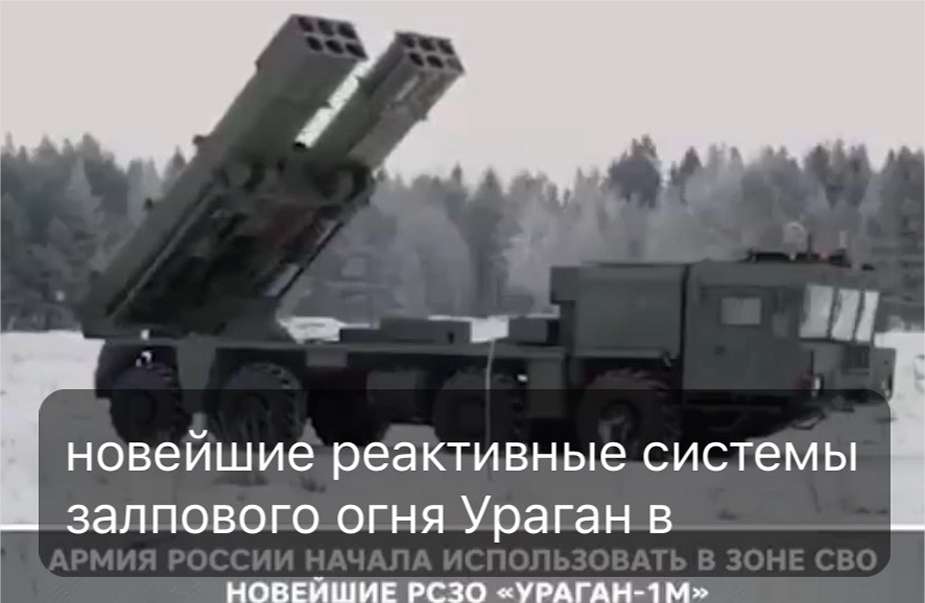According to Russian sources on January 24, 2024, the Russian company Tula NPO "Splav" may have supplied a batch of Uragan-1M bi-caliber multiple launch rocket system (MLRS) to Russian troops stationed in Ukraine. But is there evidence to suggest that Russia is deploying this new MLRS in Ukraine?
Follow Army Recognition on Google News at this link

The Uragan-1M can carry two pods with a total of 12 launching tubes for 300 mm rockets or two pods with a total of 30 smaller 220 mm rockets, providing significant firepower. (Picture source: Yandex)
According to these Russian sources, the Russian military-industrial complex has delivered an initial batch of the Uragan-1M MLRS to Russian troops stationed in an unknown region of Ukraine. Mass production of these MLRS systems seems to have begun in Russia, with claims that they are designed to withstand Western and Ukrainian Armed Forces' weaponry. Some Russian comparisons have been drawn between the Uragan-1M and the American-made M142 HIMARS system.
However, there is uncertainty regarding this deployment, as Russian sources provide differing descriptions, mentioning either the Uragan-1M based on a Belarusian MZKT-7930 8x8 wheeled chassis or a modernized version of the Soviet-era BM-27 Uragan equipped with more advanced electronics.
Verification of this information remains challenging, as the only resources available couldn't be geolocated with precision. However, it wouldn't be the first time Russia introduced new military equipment discreetly, only to later confirm its testing or deployment in Ukraine. For instance, in August 2023, Ukrainians reported the destruction of the probable prototype of the Predel-E coastal radar, which was estimated to be worth at least $200 million. They also reported the elimination of the 1K148E Yastreb-AV radar upon its arrival in Ukraine.
Another example is the T-14 Armata Main Battle Tank, which is said to have been tested in real-life conditions in Ukraine, with possible mass production starting as early as 2024. Speaking of tanks, reports also suggest that the T-80BVM Model 2023 may have been sent to Ukraine. In the domain of self-propelled artillery, more and less secretive deployments have included the 2S35 Koalitsiya-SV, the 2S43 Malva, the 2S40 Phlox, and the TOS-2 Tososchka.
The covert nature of this deployment could indicate two possibilities: it may involve the delivery of a small batch to assess the material's effectiveness, with the potential for mass production if successful, or it could be in the finalization phase. Finalization in military vehicle development includes rigorous testing, evaluation, and adjustments to ensure compliance with performance, durability, and reliability standards. This step is essential to ensure the vehicle's readiness for deployment across various operational scenarios.
The Uragan-1M is a multiple launch rocket system (MLRS) developed by Russia with the aim of replacing the aging BM-27 Uragan 220 mm and BM-30 Smerch 300 mm systems. Its development commenced in 1995 and concluded with successful trials in 2015; however, as of 2023, it had not yet been officially adopted by the Russian Army, with only six units produced.

This video, which claims that Russia has indeed deployed the Uragan-1M in Ukraine, should be taken with caution, as it appears to be several months old. (Picture source: Russian social media)
The Uragan-1M is designed for targeting area-based objectives, such as concentrations of troops, armored vehicles, artillery batteries, and airfields. Similar to the Vozrozhdenie, a new system that can serve as either an MLRS or a mine-laying system, the Uragan-1M is a multi-caliber system capable of launching rockets of various calibers, including 220 mm and 300 mm rockets. The launcher vehicle, known as the 9A53, can carry two pods with a total of 12 launching tubes for 300 mm rockets or two pods with a total of 30 smaller 220 mm rockets, providing significant firepower.
The 300 mm rockets have a maximum range of 70 km (or 90 km with extended-range rockets) and come with various warhead options, including high-explosive, incendiary, and cluster munitions. The 220 mm rockets have a maximum range of up to 34 km and can be equipped with different warheads, including chemical and anti-tank munitions.
Operating the Uragan-1M requires a crew of three, and it can be prepared for firing in just three minutes, enabling quick deployment and reducing vulnerability to counter-battery fire. It is mounted on a Belarusian MZKT-7930 8x8 wheeled chassis with a turbocharged diesel engine, ensuring good mobility. An associated reloading vehicle, the 9T249, is used to transport and reload rocket pods, further enhancing operational efficiency.
The Uragan-1M has the capability to fire the 220 mm rockets used by the BM-27 Uragan, including high-explosive fragmentation, chemical, and scatterable-mine sub-munition warheads, with a range of 35 to 40 km. As a reminder, the BM-27 can also launch various unguided artillery rockets, including 9M27F (High Explosive), 9M27K1 (anti-personnel anti-material bomblets), 9M27K2 (anti-tank mines), 9M27K3 (anti-personnel minelets), and 9M59 (anti-tank mines with directional charge).
The key distinction between the Uragan-1M MLRS and previous Russian multiple launch rocket systems is the use of packaged guides instead of the traditional ones installed on a combat vehicle during production. These packaged guides enable quicker reloading after firing a salvo, as the missiles are loaded in packages rather than individually, thereby increasing efficiency and safety. Previous MLRS systems were vulnerable due to the time-consuming reloading process, making them susceptible to adversaries.
It's important to note that the Uragan-1M's ability to fire projectiles of different calibers reduces the need for separate ammunition deliveries, simplifying logistics and offering flexibility in terms of ammunition types. Therefore, the Uragan-1M can utilize old Soviet-era stocks or more modern ammunition, depending on the situation. Lastly, the Uragan-1M features automated fire guidance and control systems. Modern electronics enable the Uragan-1M to operate efficiently by receiving real-time target information and fire adjustments from drones.















